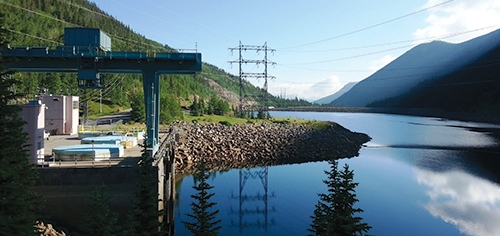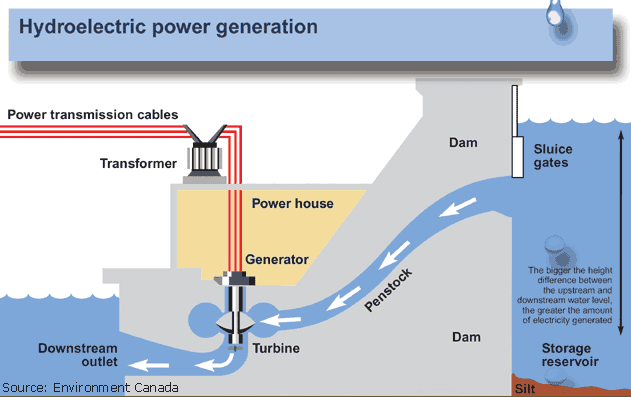The concept of Pumped Storage Hydroelectricity(PSH) as a form of energy storage within the context of a smart grid
In recent years, the world has witnessed a rapid increase in the demand for electricity, driven by factors such as population growth, urbanisation, and technological advancements. As the world continues to grapple with the challenges of meeting increasing energy demands and reducing greenhouse gas emissions, the integration of renewable energy sources into the grid has become crucial. However, the intermittent nature of renewable energy generation poses a significant challenge for grid stability and reliability. The surge in energy consumption has put immense pressure on our existing power grids, calling for innovative solutions to manage supply and demand effectively. Energy storage systems have emerged as a key solution to address these issues, with pumped storage hydroelectricity (PSH) being one of the most mature and effective technologies available.
Understanding the Smart Grid:
Before we dive into the world of energy storage, let’s briefly discuss the concept of a smart grid. The traditional power grid primarily relied on a centralized approach to generate and distribute electricity. However, with the advent of renewable energy sources, decentralised generation, and the need for improved efficiency, the smart grid has gained prominence. The smart grid is an advanced electrical grid that utilises modern technologies, such as sensors, automation, and real-time data analysis, to optimise the generation, distribution, and consumption of electricity. It enables bidirectional flow of electricity, facilitating the integration of distributed energy resources, including solar panels, wind turbines, and energy storage systems. By monitoring and responding to real-time data, the smart grid enhances reliability, resilience, and sustainability while minimizing costs and environmental impact.
Overview of Pumped Storage Hydroelectricity:
PSH is a well-established method of energy storage that utilises the gravitational potential energy of water. The process involves two reservoirs at different elevations, with a turbine-generator set located between them. During periods of excess electricity generation, typically when renewable sources like wind and solar are producing more energy than needed, the surplus electricity is used to pump water from the lower reservoir to the upper reservoir, thereby storing energy. When electricity demand increases or renewable generation decreases, water is released from the upper reservoir to the lower reservoir, flowing through the turbine and generating electricity.
Advantages of Pumped Storage Hydroelectricity:
- Large-scale storage capacity: PSH provides the ability to store vast amounts of energy. The scale of storage can range from a few megawatt-hours to several gigawatt-hours, depending on the size of the reservoirs and the power capacity of the turbine-generators. This large-scale storage capacity makes PSH particularly suitable for stabilizing the grid during periods of high demand or low renewable generation.
- Long-duration storage: One of the significant advantages of PSH is its ability to store energy for long durations. Unlike other energy storage technologies that may have limited discharge durations, pumped hydroelectricity can store energy for extended periods, ranging from several hours to days. This feature is crucial for ensuring grid reliability during prolonged periods of low renewable energy generation or unexpected disruptions.
- High efficiency and flexibility: Pumped hydroelectricity has high round-trip efficiency, typically above 70%, which means that a significant portion of the energy used to pump water uphill is recovered when the water flows downhill through the turbines. Moreover, pumped hydroelectricity offers excellent operational flexibility, enabling rapid response times to fluctuations in electricity demand or renewable energy generation. This flexibility helps to balance the grid and stabilize the frequency and voltage levels, ensuring reliable and efficient electricity supply.
Integration into a Smart Grid
Pumped hydroelectricity plays a crucial role in the development of a smart grid by enhancing grid resilience, improving renewable energy integration, and enabling demand response capabilities. Here are a few key aspects of its integration:
- Grid stability and reliability: Pumped hydroelectricity can provide grid operators with a fast-response, dispatchable energy resource to balance electricity supply and demand fluctuations. By dynamically adjusting the flow of water between reservoirs, pumped hydroelectric plants can rapidly inject or withdraw electricity from the grid, maintaining grid stability and minimizing the need for fossil-fuelled peaking plants.
- Renewable energy integration: The intermittent nature of renewable energy sources can create challenges for grid operators. Pumped hydroelectricity acts as a buffer, storing excess renewable energy when generation exceeds demand and releasing stored energy during periods of low renewable generation. This integration allows for better utilization of renewable resources, reducing curtailment and maximizing the contribution of renewable energy to the overall energy mix.
- Demand response: In a smart grid, pumped hydroelectricity can facilitate demand response programs by incentivising consumers to shift their energy consumption patterns during periods of low demand or high renewable energy generation. By offering lower electricity prices during these times, consumers can be encouraged to use electricity when it is abundant, further optimising the grid and promoting the efficient use of energy.
In the quest for a sustainable and efficient energy future, the smart grid and energy storage systems are critical components. Pumped Storage hydroelectricity is a proven and versatile form of energy storage that plays a critical role in the development of a smart grid. Its large-scale storage capacity, long-duration capabilities, high efficiency, and operational flexibility make it a valuable tool for stabilizing the grid, integrating renewable energy sources, and enabling demand response. By enabling the integration of renewable energy sources, providing grid stability, and managing peak loads, PSH contributes to a cleaner, more reliable, and resilient grid. As the world transitions towards a more sustainable energy future, PSH will continue to be an integral component of the evolving smart grid architecture. As we continue to invest in smart grid infrastructure and explore innovative energy storage solutions, PSH will undoubtedly play a pivotal role in shaping the future of our energy landscape.
Bibliography
- U.S. Hydropower Market Report January 2021, DOE/EE-2088 • January 2021: Accessed on May 01, 2023: https://www.energy.gov/sites/default/files/2021/01/f82/us-hydropower-market-report-full-2021.pdf
- European Small Hydropower Association. 2012. Small Hydropower Roadmap: Condensed Research Data for EU27. Accessed on November 26, 2019: https://www.bt-projects.com/wp-content/uploads/documents-public/Rivers/ ESHA-2012-Small-Hydropower-Roadmap-Condensed-reserach-data-for-EU-27.pdf
- Levine, A., T. Curtis, and B. Kazerooni. 2017. Regulatory Approaches for Adding Capacity to Existing Hydropower Facilities. NREL/TP-6A20-70121. National Renewable Energy Laboratory, Golden, Colorado, USA.
- A. Rahman, F. H. Khan, M. S. Bashi, and M. A. Mannan, “Smart Grid Application of Pumped Storage Hydroelectricity for Renewable Energy Integration,” 2017 IEEE Power & Energy Society General Meeting, 2017. DOI: 10.1109/PESGM.2017.8274379
- D. S. Kirschen, “Demand Side Management: An Important Smart Grid Application,” 2011 IEEE Power and Energy Society General Meeting, 2011. DOI: 10.1109/PES.2011.6039343
- A. Abbasi and M. Abbasi, “Pumped Hydro Storage: Potential for Transformation into a Smart Grid-Interactive and Environmentally Friendly Option,” Renewable and Sustainable Energy Reviews, vol. 14, no. 4, pp. 1187-1198, 2010. DOI: 10.1016/j.rser.2009.11.021
- Y. Xie, P. S. Palensky, and M. Wimmer, “Analysis of the Impact of Pumped Hydro Storage Systems on the Distribution Grid,” 2012 IEEE Power and Energy Society General Meeting, 2012. DOI: 10.1109/PESGM.2012.6345116
- S. F. Bush, “Smart Grid and Storage: Pumped Hydroelectric Energy Storage,” 2015 IEEE 14th International Conference on Machine Learning and Applications, 2015. DOI: 10.1109/ICMLA.2015.179
- M. Q. Islam, S. H. Ahmed, and S. M. Muyeen, “Pumped Storage Hydroelectricity for Energy Storage and Ancillary Services in a Smart Grid,” 2018 IEEE 8th Annual Computing and Communication Workshop and Conference (CCWC), 2018. DOI: 10.1109/CCWC.2018.8301689
- P. Lopes, R. Aslan, and J. Matos, “Optimal Operation of Pumped Hydro Storage for Smart Grid Applications,” IEEE Transactions on Sustainable Energy, vol. 5, no. 3, pp. 976-983, 2014. DOI: 10.1109/TSTE.2013.2293825
- R. Hakala, S. Repo, and J. Partanen, “Flexible Demand Response from Pumped Storage Hydro: A Case Study for Smart Grid Integration,” Energies, vol. 10, no. 4, p. 470, 2017. DOI: 10.3390/en10040470
- C. Bauer, A. Eichmanis, and J. O. G. Bjarne, “Smart Grid Integration of a Nordic Smart Energy System,” 2018 IEEE International Conference on Environment and Electrical Engineering and 2018 IEEE Industrial and Commercial Power Systems Europe (EEEIC / I&CPS Europe), 2018. DOI: 10.1109/EEEIC.2018.8494217
- F. F. Katiraei, R. J. Kamwa, and C. R. Martucci, “Optimization of Pumped-Storage Hydro Generation and Load Management in a Smart Grid Environment,” IEEE Transactions on Smart Grid, vol. 2, no. 3, pp. 456-465, 2011. DOI: 10.1109/TSG.2011.2144611
This content is restricted to site members. If you are an existing user, please log in. New users may register below.

